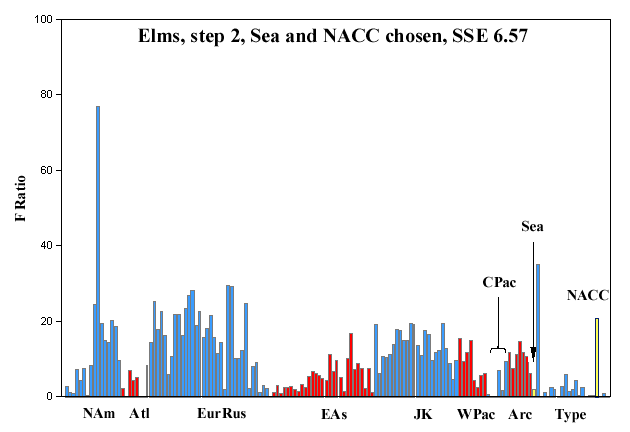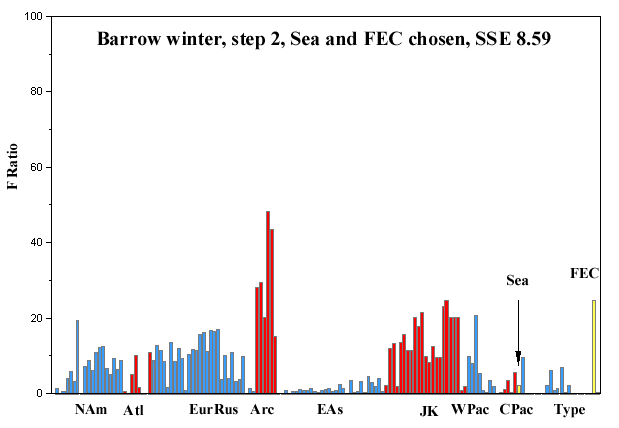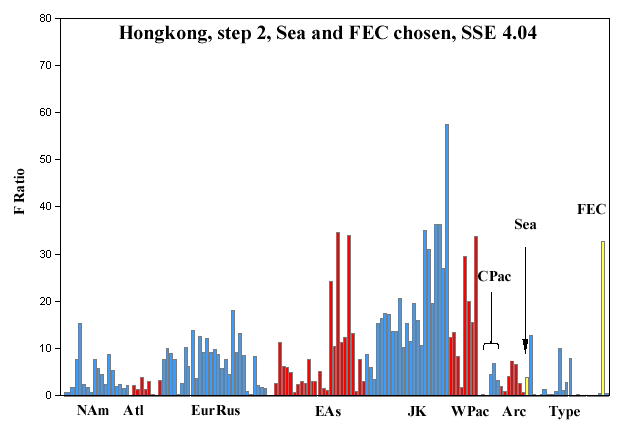
Summary of plots for step 2
The performance of the extended tracer system can be summarized by showing the step 2 plots for the various sites considered to date. We present them in the order they are referred to in the text: the eight sites with clear solutions followed by the two sites with greater or lesser difficulties.
Narragansett, Rhode Island
We begin with Narragansett, RI, our home base and a site with
several hundred samples analyzed. Step 2 yields a "background" of high
F-ratios in eastern North America, parts of Europe and Russia, and Japan/Korea.
The eastern North American region, where Narragansett is located, is the clear
starting place because its F-values are consistently high and because it
contains the two highest place-signatures, West Point and Prince George County.
Thus step 2 for Narragansett points to the right answer.

Elms (Maryland)
Step 2 for Elms was quite similar to step 2 for Narragansett,
also in the northeastern United States. Both cases pointed most strongly to
nearby sources in the Northeast, and secondarily to more-distant sources in
Europe. The Northeast proved to be the correct answer for both sites.

Wye (Maryland)
Step 2 for Wye is similar to that for Elms, pointing strongly to
nearby sources in the Northeast and secondarily to more-distant sources in
Europe. The Northeast again proved to be the ultimate answer.

Lerwick, UK
We move to Lerwick, a site in the United Kingdom. As
opposed to Narragansett, Lerwick's step 2 pattern has a clear and strong center—Europe,
its neighborhood, with the highest value being for the Shetland Islands, just
north of Scotland. Thus the F-ratios for Lerwick show local sources, a
prediction borne out by the full apportionments.

Northern Norway
Step 2 for northern Norway pointed to a mix of sources in
Europe and the Arctic, with lesser indications for Japan/Korea. The
apportionments eventual gave the nod to Europe (Petten), with lesser
contributions from the Arctic (Norilsk).

Barrow winter
We present two figures for Barrow winter because we had to
apportion it separately with 19 and 22 elements. The figure below is for the
starting point of 22 elements. It shows the highest F-ratios for five other
Arctic sites, much lower values for Japan/Korea, lower values for North America
and Europe, and nothing for East Asia. The apportionments bore out the Arctic
sites, but with a poor fit.

The second step 2, shown below, used 19 elements (without the marine Na, Mg, Ca). Its results seemed more definitive, in that the Arctic sites stood out better from the others, and North America fell relative to Europe and Russia. The apportionments showed three of the Arctic sites working together (Northern Norway, Ny-Ĺlesund, Laptev Sea). The fit was also much better than for 22 elements.

Hong Kong
Step 2 also works well for average Hong Kong aerosol, as
shown below. The highest F-ratios are found for East Asia, Japan, Korea, and
coastal islands of the West Pacific such as Kenting (on Taiwan), Okinawa, and
Cheju (south of South Korea). North America, Europe and Russia, and the Central
Pacific are not in contention.

Amagasaki
The Japanese city Amagasaki is next. It is no surprise
that the locations with the highest F-ratios are other Japanese cities. This
prediction is also borne out by the full apportionments.

Midway spring
Midway spring contains a huge component of Chinese desert
dust (far right). The remaining F-ratios seem to show a broad but irregular peak
in East Asia, which is eventually resolved into the Yellow Sea and Beijing
suburbs. This step 2 points correctly to Far Eastern dust and pollution.

Apportionments with difficulties
Step 2 was deceiving for Jungfraujoch. On the one hand, it
predicted correctly that Japan and Korea would dominate the final apportionment.
On the other hand, it failed to show the existence of a second, hidden solution
that involved sources in the UK. The fit was also much better. It is worth
noting that the UK signatures rank second to Japan/Korea here.

Lin'an
If Jungfraujoch was a half problem, Lin'an (SW of
Shanghai) is a full problem. Its step 2 does not point toward any particular
source region except possibly part of East Asia or Japan. Of these, East Asia is
probably the correct one. Why this step 2 looks as it does is not yet clear to
us.

Summary of the results for step 2
Narragansett, RI—points to
Eastern North America, the final answer.
Elms—points strongly to nearby sources in the northeastern
U.S., the final answer.
Wye—points strongly to nearby sources in the northeastern
U.S., the final answer.
Lerwick, UK—points strongly to other UK sources, the
logical answer.
Northern Norway—points to Europe and the Arctic, the
eventual answer.
Barrow winter—points strongly to sites on the other side of
the Arctic, which is correct.
Hong Kong—points strongly to East Asia, Japan/Korea, and
nearly coastal Pacific islands—all obvious Far East sources.
Okinawa spring—two East Asian sources.
Okinawa fall—also two East Asian sources.
Amagasaki, Japan—points strongly to other Japanese sources,
the most logical answer.
Midway spring (central North Pacific)—Desert dust and
pollution from China.
Jungfraujoch—points first to Japan, which is too far away,
and then to European sources, which are much more logical.
Lin'an—point to no particular source region except possibly
East Asia, the likely actual source.
Score—11.5 of 13 (88%).
We will continue to add cases.